近日,来自西安电子科技大学、哈尔滨工业大学可调谐(气体)激光技术国家级重点实验室的联合研究团队发表了《T型光声池的光声光谱技术用于基于三重共振模态的多组分气体的同时检测》论文。
Recently, the joint research team from School of Optoelectronic Engineering, Xidian University, National Key Laboratory of Science and Technology on Tunable Laser, Harbin Institute of Technology, published an academic papers T-type cell mediated photoacoustic spectroscopy for simultaneous detection of multi-component gases based on triple resonance modality
油浸式电力变压器是现代电力分配和传输系统中最重要的绝缘设备之一。通过同时测量绝缘油中的溶解气体,如一氧化碳(CO)、甲烷(CH4)和乙炔(C2H2),可以在电力变压器的过热、电弧和局部放电故障的早期诊断中提供合适的解决方案。变压器故障主要可分为过热故障和放电故障。CO、CH4和C2H2的含量变化是变压器故障的主要指标。过热故障包括裸金属过热、固体绝缘过热和低温过热。裸金属过热的特征是烃类气体(如CH4和C2H2)浓度的上升。上述两种气体的总和占总烃类气体的80%以上,其中CH4占较大比例(>30 ppm)。CO的浓度(>300 ppm)强烈指示固体绝缘过热和变压器故障中的低温过热。当变压器处于放电故障时,C2H2会急剧增加(>5 ppm,占总烃类气体的20%-70%)。因此,本研究选择CO、CH4和C2H2作为目标分析物。传统的多组分气体定量检测方法,如气相色谱仪、半导体气体传感器和电化学传感器,在实时监测、恢复时间、选择性和交叉敏感性方面存在一定限制。基于光声光谱技术的光学传感器平台具有高灵敏度、高选择性、快速响应、长寿命和成熟的传感器设备等优点,在多组分气体传感领域发挥着重要作用。已经开发出多种基于光声光谱技术的多组分气体传感器模式,如傅里叶变换红外光声光谱模式、基于宽带检测的热辐射体或黑体辐射体使用多个带通滤波器、多激光器与时分复用(TDM)方法的结合,以及采用多共振器和频率分割复用(FDM)方案。然而,由于宽带光源的相对弱强度,弱光声(PA)信号易受到背景噪声的干扰,这是高灵敏度检测的主要障碍。
Oil-immersed power transformer is one of the most important insulation equipment in modern power distribution and transmission systems. Simultaneous measurements of the dissolved gases in insulating oil, such as carbon monoxide (CO), methane (CH4) and acetylene (C2H2), can represent a suitable solution in early diagnosis of overheating, arcing and partial discharge failures of power transformers . Transformer fault can mainly be divided into overheating fault and discharge fault. The content changes of CO, CH4, and C2H2 are the main indicators of transformer failure. Overheating fault includes bare metal overheating, solid insulation overheating and low temperature overheating. The bare metal overheating is characterized by the rising concentration of hydrocarbon gas, such as CH4 and C2H2. The sum of the above two gases accounts for more than 80% of the total hydrocarbon gas, and CH4 accounts for a larger proportion (>30 ppm). The concentration of CO (>300 ppm) strongly indicates the solid insulation overheating and the low temperature overheating in the transformer failure. When the transformer is in discharge fault, the C2H2 will increase dramatically (>5 ppm, 20%− 70% of the total hydrocarbon gas). Therefore, CO, CH4, and C2H2 are selected as the target analytes in this work. The traditional quantitative detection of multiple analytes, such as gas chromatographs, semiconductor gas sensors and electrochemical sensors, were limited in terms of real time monitoring, recovery time, poor selectivity and cross sensitivity. Photoacoustic spectroscopy (PAS)-based optical sensor platforms, which feature the advantages of high sensitivity, high selectivity, fast response, long lifetime and well-established sensing devices, have played an important role in the field of multi-component gas sensing. Various PAS-based multi-gas sensor modalities have been developed, such as Fourier transform infrared PAS modality, broadband detection based thermal emitters or blackbody radiators using several band-pass filters, the use of multi-lasers combined time-division multiplexing (TDM) methods , and multi-resonators with frequency-division multiplexing (FDM) schemes. Due to the relatively poor intensity of the broadband source, the weak photoacoustic (PA) signals were sensitively affected by the background noise, which was a major obstacle to highly sensitive detection.
由于吸收和共振圆柱体共同决定了其共振频率,设计并验证了一种T型光声池作为适当的传感器。通过引入激励光束位置优化,从模拟和实验中研究了三种指定的共振模式,呈现了可比较的振幅响应。使用QCL、ICL和DFB激光器作为激发光源,同时测量CO、CH4和C2H2,展示了多气体检测的能力。
A T-type photoacoustic cell was designed and verified to be an appropriate sensor, due to the resonant frequencies of which are determined jointly by absorption and resonant cylinders. The three designated resonance modes were investigated from both simulation and experiments to present the comparable amplitude responses by introducing excitation beam position optimization. The capability of multi-gas detection was demonstrated by measuring CO, CH4 and C2H2 simultaneously using QCL, ICL and DFB lasers as excitation sources respectively.
图片显示了配备了T型光声池的基于PAS的多组分气体传感器配置的示意图。使用三个激发激光器作为激光源,包括DFB ICL(HealthyPhoton,型号HPQCL-Q)、DFB QCL(HealthyPhoton,型号QC-Qube)和NIR激光二极管(NEL),分别在2968 cm−1、2176.3 cm−1和6578.6 cm−1处发射,以实现对CH4、CO和C2H2的同时检测。ICL、QCL和NIR激光二极管在目标吸收波长处的光功率分别为8 mW、44 mW和32 mW,通过热功率计(Ophir Optronics 3 A)进行测量。所有激光源都通过调节电流和温度控制来驱动。
A schematic diagram of PAS-based multi-component gas sensor configuration equipped with the developed T-type PAC is shown in Fig. Three excitation laser sources, including a DFB ICL (HealthyPhoton, model HPQCL-Q), a DFB QCL (HealthyPhoton, model QCQube) and an NIR laser diode (NEL) emitting at 2968 cm− 1, 2176.3 cm− 1 and 6578.6 cm− 1, were employed to realize the simultaneous detection of CH4, CO and C2H2. The optical powers of the ICL, QCL and NIR laser diode measured by a thermal power meter (Ophir Optronics 3 A) at the target absorption lines were 8 mW, 44 mW and 32 mW, respectively. All the laser sources were driven by tuning the current and temperature control.

Fig. The schematic diagram of multi-resonance PAS-based gas sensor configuration equipped with the developed T-type PAC for multi-component gas simultaneous detection. Operating pressure: 760 Torr.
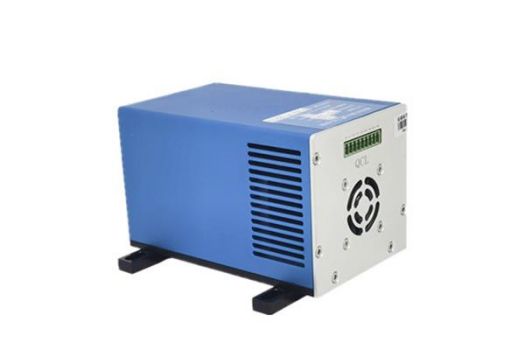
HealthyPhoton, model HPQCL-Q
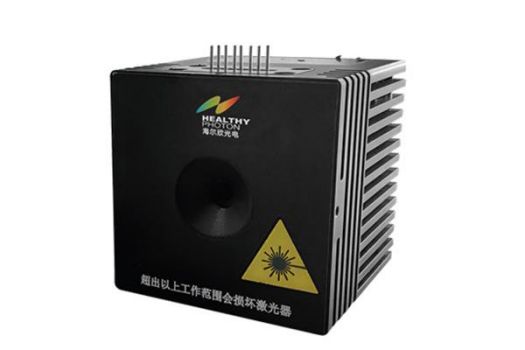
HealthyPhoton, model QCQube
结论
建立了基于T型光声池的多共振光声光谱气体传感器,并验证其能够进行多组分同时检测,达到ppb级别的灵敏度。通过有限元分析(FEA)模拟优化和实验光束激发位置设计,三个指定的谐振频率的光声响应相互比较,确保了同时检测多种微量气体的高性能。选择了CO、CH4和C2H2这三种可燃气体作为目标气体,使用QCL(4.59 µm,44 mW)、ICL(3.37 µm,8 mW)和NIR激光二极管(1.52 µm,32 mW)作为入射光束进行同时检测验证。F1模式下,光束照射到缓冲腔体壁上,信噪比(SNR)相比通过吸收圆柱体的情况提高了4.5倍。实验得到了CO、CH4和C2H2的最小检测限(1σ)分别为89ppb、80ppb和664ppb,对应的归一化噪声等效吸收系数(NNEA)分别为5.75 × 10−7 cm−1 W Hz−1/2、1.97 × 10−8 cm−1 W Hz−1/2和4.23 × 10−8 cm−1 W Hz−1/2。对湿度交叉敏感性进行改进的研究提供了对光声光谱传感器在湿度松弛相关效应方面的更好理解。利用单个光声腔体和单个探测器进行多组分气体传感的这种开发的光声光谱模式,具有在电力变压器故障的早期诊断方面的独特潜力。
Conclusions
A T-type cell based multi-resonance PAS gas sensor was established and verified to be capable of multi-component simultaneous ppb-level detection. By the FEA simulation optimization and experimental beam excitation position design, the PA responses of the three designated resonant frequencies are comparable which guarantees the high performance of multiple trace gas detection simultaneously. The three combustible species of CO, CH4 and C2H2 were selected as target gases for the simultaneous detection verification using a QCL (4.59 µm, 44 mW), an ICL (3.37 µm, 8 mW) and a NIR laser diode (1.52 µm, 32 mW) as incident beams. The SNR for F1 mode with the beam irradiating on the buffer wall was increased by 4.5 times than that of passing through absorption cylinder. The experimental MDLs (1σ) were achieved as of 89ppb (CO), 80ppb (CH4) and 664ppb (C2H2) have been acquired, respectively, corresponding to the NNEA coefficients of5.75 × 10−7 cm−1 W Hz−1/2, 1.97 × 10−8 cm−1 W Hz−1/2 and 4.23 × 10−8 cm−1 W Hz−1/2. An improved humidification investigation regarding cross-sensitivity analysis provides a better understanding of PAS sensors in humidity relaxation related effects. This developed PAS modality of utilizing a single PAC and a single detector for multicomponent gas sensing exhibits unique potential for early diagnosis of power transformer failures.
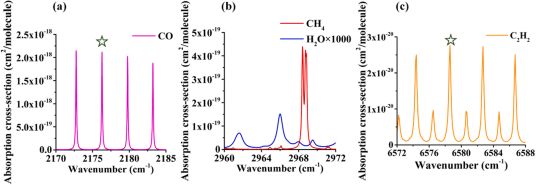
Fig. 1. Simulated spectral distribution characteristics of CO, CH4 and C2H2 based on HITRAN Database. Temperature and pressure: 296 K and 1 atm respectively.
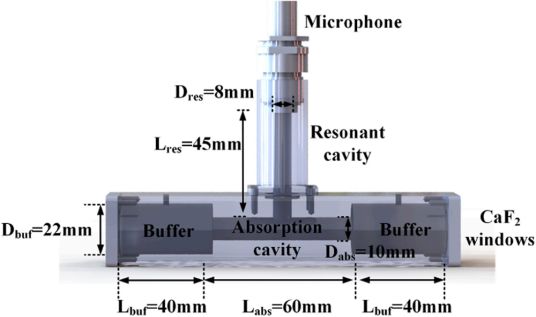
Fig. 2. Schematic structure of the developed T-type PAC.

Fig. 3. Simulated sound pressure distribution of T-type PAC model for the three selected resonance modes by FEA method. Color bar: Simulated sound pressure (Pa).
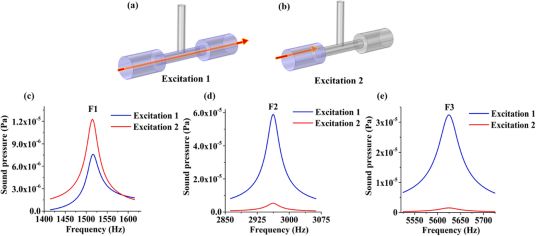
Fig. 4. Simulation results of the T-type PAC acoustic characteristics with the incident beam position optimization. (a) and (b): Two different incident ways of the excitation beam; (c), (d) and (e): The simulated pressure amplitude response vs. frequency for F1, F2 and F3 detection, respectively.
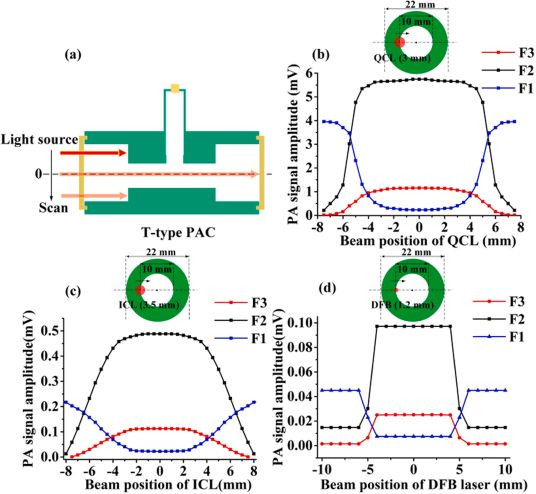
Fig. 6. The experimental results of PA signals for different resonance modes by scanning the incident excitation beam. (a) Schematic diagram of the light source scanning process in the T-type PAC. Dashed line: Central axis. (b) The PA amplitude of 100 ppm CO vs. the beam position of ICL source. (c) The PA amplitude of 50 ppm CH4 vs. the beam position of ICL source. (d) The PA amplitude of 50 ppm C2H2 vs. the beam position of DFB laser diode. Insert: The irradiated surface of PAC.
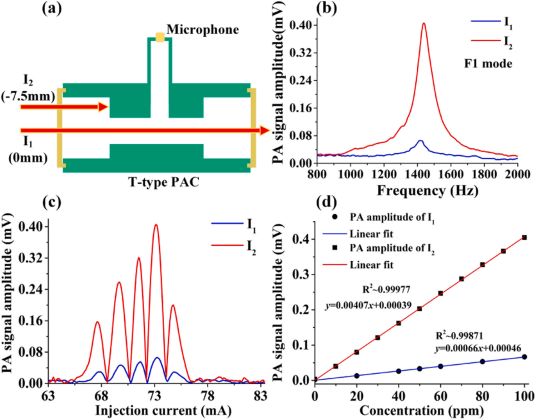
Fig. 7. The experimental results for CH4 detection with the incident beam position optimization. (a) Two different ways (I1, I2) of incident excitation beam using ICL for CH4 measurement; (b) The PA amplitude vs. frequency of F1 for the two incident ways; (c) The PA spectra of 100 ppm CH4 in the ICL tunning range using both incidence ways; (d) The PA signal amplitude of CH4 vs. gas concentration for two incidence ways.

Fig. 8. Noise level analysis of F1, F2 and F3 modes for two incidence ways.
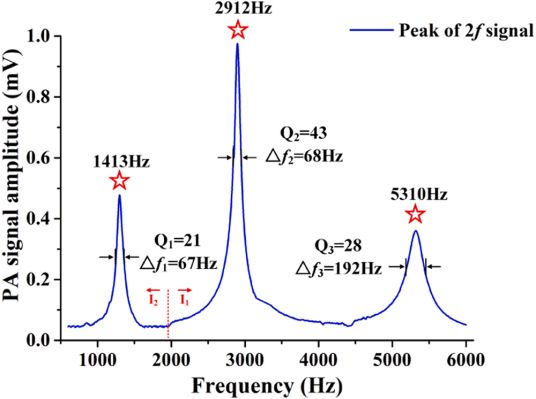
Fig. 9. Experimental frequency responses of the developed T-type PAC.

Fig. 10. The PA signal amplitudes vs. laser modulation amplitudes for multi-component gas sensing. (a) The ICL modulation amplitudes for 100 ppm CH4 detection; (b) The QCL modulation amplitudes for 400 ppm CO detection; (c) The NIR laser diode modulation amplitudes for 100 ppm C2H2 detection.

Fig. 11. The experimental results for simultaneous detection of multi-component gases. (a), (b) and (c): Measured 2f-PAS spectral scans of the CO, CH4 and C2H2 absorption features for F1, F2 and F3 modes, respectively.
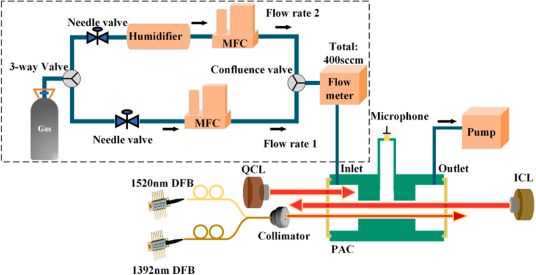
Fig. 12. Schematic of the improved humidification system for humidity control.